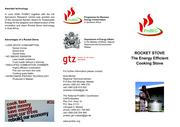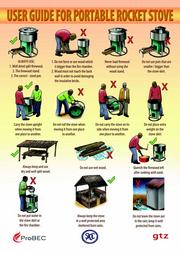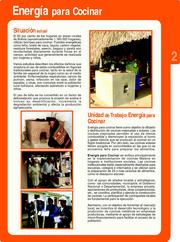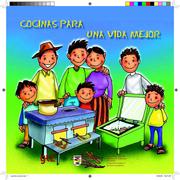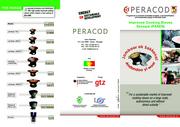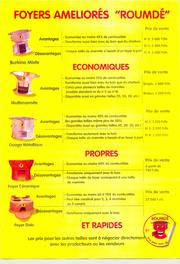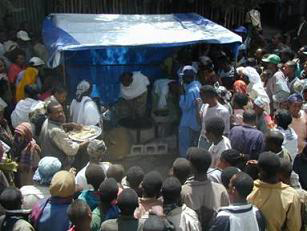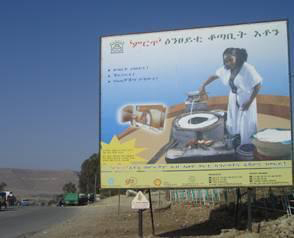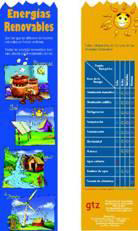Knowledge fuels change - Support energypedia!
For over 10 years, energypedia has been connecting energy experts around the world — helping them share knowledge, learn from each other, and accelerate the global energy transition.
Today, we ask for your support to keep this platform free and accessible to all.
Even a small contribution makes a big difference! If just 10–20% of our 60,000+ monthly visitors donated the equivalent of a cup of coffee — €5 — Energypedia would be fully funded for a whole year.
Is the knowledge you’ve gained through Energypedia this year worth €5 or more?
Your donation keeps the platform running, helps us create new knowledge products, and contributes directly to achieving SDG 7.
Thank you for your support, your donation, big or small, truly matters!
Creation of Public Awareness for Improved Cookstoves (ICS)
Cooking Energy System | Basics | Policy Advice | Planning | Designing and Implementing ICS Supply | Designing and Implementing Woodfuel Supply | Climate Change | Extra
Overview
The Role of Information Campaigns: It is very difficult to influence the process of social change. Experience from many stove projects has shown that successful information campaigns to raise public awareness and interest in improved household technologies are a precondition for successful stove introduction and dissemination. Without campaigns highlighting the many problems associated with traditional cooking energy, and describing affordable solutions, the dissemination of energy-efficient household technologies is likely to fail. Such campaigns need to be part of a package of activities, as on their own, they will not necessarily convert into demand for stoves.
Information on the target communities is key to setting the agenda and identifying the best strategies. Who will be reached, and by which kind of information? Different target groups require different modes of communication in order to maximise the size of the audience.
This chapter focuses on general sensitisation in the field of cooking energy. It provides links to other source material for more detailed studies on the issue, and some practical examples. For product marketing look at commercialisation although there might be some overlap in these areas.
Developing a Communication Strategy
Every improved stove project interacts with different groups in a given society to provide them with information regarding the relevance of cooking energy issues, the existence and work of the project, different products promoted, and research results. A communication strategy helps to clarify and analyze different goals and needs for making this communication process target-oriented and effective.
Key points in a communication strategy
|
Please consider:
- What are your main messages?
- What do you want to say?
- Is the message different for different audiences? (core message tailored according to target groups)
- Summarize message in 3 key points?
- Story to tell?
- Human interest
- Ask the “so what” question. Why should we care?
| Overall objective of your communications activities |
WHO: Audiences Break target users into sub categories and describe them detailed |
WHAT: Information needs in as much details as possible. |
HOW: Products / tools HOW do we reach them? |
WHY do we want to reach them? Why are they important? | Barriers? | Other comments
|
Identifying the Target Groups
The first step for developing a communication strategy is to identify your target groups. Why is it important to communicate with these groups? What do you plan to achieve through each link? Are there any priority audience groups?
To ensure sustainability of the interventions beyond the end of a project, involvement is needed, not only with the direct target group such as the rural poor, but also with government partners, non-governmental institutions, the private sector, the general public, and organizations specific to the area. Only if they recognise the relevance of the topic, if they are willing to carry on different activities once the project has come to an end the probability of continued stove supply and demand will be much higher.
Furthermore, as part of the international community, experiences should be shared with international colleagues through expert dialogue and knowledge sharing. This not only prevents reinventing the wheel but also raises your project's and organisations's profile.
Analysing the Different Information Needs
The next step is to think about the different information needs of the target groups to enable them to take positive action for improved energy provision. What kind of information would interest them? What information is needed to convince them of the importance of the issue? Do the target communities have basic background information about the benefits of improved technologies? Do any of the communities have any experience of efficient stoves? The approach will need to be adapted if any community has had negative experiences from previous projects which have failed through poor quality stoves or the like. If people are unaware of the problems, the first step is to raise awareness by informing them about the importance of the issue, such as the correlation between smoke from open fires and respiratory diseases.
Barriers
It can also be worthwile thinking about the possible barriers to reaching your target audiences: bad internet connections, no time for reading long studies, no personal contact, hierarchies in ministries, etc. This might depend on the communication channel you choose but it also might depend on interests and priorities of single persons.
Spreading the Message / Product and Tools
Think about how to spread your messages. Depending on the type of message and your target group there are several channels; leaflets, radio or TV-spots, street theatre or press releases. Some basic knowledge about the users of the different media / communication channels is valuable when deciding which one best reaches each target group.
Points to consider
|
General key messages (examples):
- Without energy people cannot cook, read at night, local health clinics cannot keep medicine cool, and use modern devices or communications technologies.
=> So, without energy no development: Access to energy is fundamental to achieving the MDGs
- Billions of people don’t have access to electricity.
- One third of the people on the globe use firewood, charcoal, and dung for cooking. They mainly rely on traditional cook stoves, which are very inefficient and emit a lot of toxic smokes.
- Cooking is life. But cooking also kills almost 2 mio. people per year.
Resources and Timescales
Develop a plan:
- Who does what when?
- Plan with dates and milestones (Scan horizon for events/activities that your topic/message/story can slot into - higher profile for little extra effort.When is the best time to reach key audiences, e.g. MPs?)
- How much will it all cost?
Baseline and Evaluation
Evaluating communications and information work is quite challenging. However, you should try to get an idea how your awareness raising efforts show an impact on your target audiences. How will you know if you have succeeded and met your objectives? Think about useful indicators right from the beginning.
Don't forget to collect data before starting with your communication activities - otherwise the impacts will be difficult to know.
If you are planning a massive, nation-wide awareness raising campaign one possibility could be to make regular telephone or internet surveys before, during and after the campaign. To this end, collaboration with a market or opinion research institute would be necessary. But there are also other possibilites such as qualitative interviews or web statistics to know more about the use of your communication tools by your target audience.
To see if others are referring to your products simple google research or google alerts can help, too.
Example evaluation questions for surveys and interviews, e.g.:
- Who are our users? What proportion is from our target groups?
- What use do they make of our services?
- How satisfied are people with our services (e.g. newsletter?)
- What factors inhibit/make the services accessible, relevant, credible and diverse?
- What do our users most value about our services?
- How do they think we can improve?
Additional Information on Communication Strategies
| Download / Source |
Description |
|
GIZ Tajikistan: presentation on environmental communication. It reveals serveral concepts on KAP (Knowledge, Attitude, Practice), on media selection, on message design, and on target groups. | |
|
This is a Bolivian campaign by GTZ PROAGRO (see presentation in Spanish). | |
|
Valerie A. Curtis, PhD, Nana Garbrah-Aidoo, MPH, Beth Scott, MS. In: American Journal of Public Health. April 2007, Vol 97, No. 4. This is a helpful example of a professional social marketing strategy for promoting hand washing with soap. | |
|
improving sexual and reproductive health for poor and vulnerable populations. This strategy paper from DFID can be a helpful example for developing a communication activities plan, e.g. defining target audiences and their profiles, purposes and contents of communication as well as monitoring & evaluation of activites. | |
|
This DFID document provides an overall communication strategy for targets. | |
|
Guidelines. DFID 2005. This guidebook shows different approaches for monitoring and evaluating communication measures. | |
|
Extract from: Successful Communication. A Toolkit for Researchers and Civil Society Organisations. Overseas Department Institute 2005. The most important points to consider in developing a communications strategy, 2 pages. |
Reaching Target Groups
To ensure sustainability of project activities, the society needs to take ownership of their household energy issues.
To sensitise the community, the most important target groups for a communication strategy comprise:
- the public sector (e.g. politicians, extension services, GOs)
- the civil society (e.g. health centres, NGOs, faith communities)
- the general public
- customers (for product marketing to this group see Commercialisation of Cookstoves.
For developing a social marketing strategy, it is recommended that the project team collaborates with marketing experts, PR and event agencies.
In general, do not bore or blame the audience. Instead of telling people what they are doing wrong; tell them how they could improve. Consumer research has shown that messages that appeal to the emotions are highly memorable and thus can be more effective: and remember that a picture is worth a thousand words.
The Public Sector and the Civil Society
To assure sustainability of project activities, mainstreaming biomass energy issues into the activities of other institutions is an important tool. Ideally, in the longer term, local organisations, the private sector and governmental bodies should take over project responsibilities. Since they will need to continue information and sensitisation campaigns, they need to have relevant knowledge on household energy issues. This knowledge should come from their involvement with the project.
Important target groups are political leaders and local authorities, and national or international organisations and institutions such as NGOs, health centres, or religious centres. Educational institutions can play a significant role in sensitising people about the need for improved cookstoves. Children and students are an important target group (and thus especially teachers and professors who act as multipliers) because changing cooking habits takes a long time. In addition, parents can be reached via activities at school.
Examples of information needed by the public sector and the civil society
- The broad spectrum of problems associated with the use of traditional biomass
- The availability of alternatives such as energy-efficient technologies and techniques
- The need for a favourable political framework (both nationally and locally) for the efficient use of biomass
- Details of the project approach and its activities, including the services it provides as a facilitator for enhanced market introduction of improved stoves.
- The relevance of cooking energy to extension staff, local NGOs, and ministries in their particular fields of work; for example, to health or forestry
- How to integrate efficient use of biomass energy into their activities
- The most energy-efficient technologies that are also beneficial to health and that save natural resources as well as money
- Other information related specific to the location, such as specific technical solutions or the schools and colleges involved in dissemination
Appropriate communication media for the public sector and the civil society
- Events, such as stakeholder workshops, demonstrations and field trips.
- Presentations, studies.
- Leaflets, posters, flyers etc. (Uganda flyer, HERA poster).
- Media coverage.
- Training modules.
- Sensitisation of those with HIV and their cooking energy needs (see ProBEC presentation “The role of biomass energy conservation in HIV/AIDS mitigation").
- Educational institutions:
- school books, fary tales (see Bolivia Cuentos Cocinas 4MB, módulos didácticos (PDRS) and bookmarks Peru)
- development of curricula
- Test centres at schools, training of teachers, special events
- Use of efficient stoves in school kitchens.
The General Public
For creating awareness among the population on a national scale, information and sensitisation have to be less specific. The general public can be reached mainly via regional or national media, and people can be contacted directly during public events. Principally, each and every person - be it a politician or member of a NGO or a customer - is also part of the general public. Thus, it is worthwile to consider if a general nation wide media campaign targeting the broad public is worth the effort and money or if it is more effective to address specific target groups directly.
Awareness Creation via The Media
To reach very large numbers of people successfully, basic knowledge is needed about what media resources are available, and how they can best be used. For instance; is it more cost-effective to use TV spots or radio programmes, since production and broadcasting can be expensive? Are the ‘traditional’ means of communication, like flyers, poster, street theatre, more effective? If you elect to use radio or TV, make sure that your spot or feature is aired at peak times when many people are about - not in the middle of the night. Instead of broadcasting long and scientific programmes, place the messages into popular radio or TV soaps and movies.
To get free, or low-cost, media coverage of your project (which can be more genuine than paying for advertisements), think about special events, sponsoring activities such as football games or fashion shows, or presenting the project to the press during a field trip. Make sure that people, especially journalists, know about the up-coming event (posters, press releases) and ensure that they know how to reach you. Research and monitoring data showing what has been achieved are good reasons for highlighting your work to the public, both nationally and internationally.
Examples of what the general public should know
- The many problems associated with the inefficient use of biomass.
- That energy-efficient alternatives do exist, and that they are affordable, modern and adapted to meet their cooking needs.
- Energy-efficient technologies are also beneficial to health and save money and natural resources.
Appropriate communication media for the general public
- TV spots, radio soaps, features, games (Burkina Faso, Ethiopia, Bolivia).
- Slideshows (Uganda The Energy-Saving Stove Projekt 2007: available on youtube).
- Calendars, flyers, posters.
- Murals, billboards.
Conventional media approaches:
- Press releases to inform journalists about events, studies that show the impact of your activities etc.
- Interviews
- Offering articles / information to newspapers
- Inviting journalists to visit the project
- Compiling a press map with the key messages, background info on the project, and human interest stories about e.g. how the use of an efficient stove changed a woman's life or how a producer could pay for education of his/her children thanks to stove business.
Raising awareness through direct contact with the public
Cooking demonstrations at markets, plays or participation in trade fairs, are helpful to inform the public about household energy and improved stoves in a very immediate way. Demonstrating the fuelwood saving potential of an energy-efficient stove can be very impressive; much more conclusive than reading about it. To reach a mass audience, publicity for the event has to be strong, and those facilitating the event have to be trained carefully to make it a success: it is best if people can buy stoves right away, at the event (Commercialisation of Cookstoves).
Appropriate communication activities for the general public
- Street theatre, which focuses on household energy as the central theme.
- Sponsoring of events (e.g. the project in Burkina Faso sponsored football teams and a fashion show.)
- Events, such as ‘open door days’ where the project as well as workshops can be visited
- Public cooking demonstrations.
- Participation in trade fairs.
Give-aways (such as T-shirts, hats, bags) are usually a product promotional tool. However, if used for sensitivity, they should focus on either the product, label and / or the message. They should not raise awareness of the project, as this strategy can cause problems, particularly if people feel envious of those receiving the give-aways. Raising the profile of the project, rather than the product, can cause problems in sustainability.
Customers – The Main Target Group
The communication strategy towards the main target group, the customers for the stoves, includes both product marketing and sensitisation.
Pure product marketing will end up the task of the producers, rather than the project (Commercialisation of Cookstoves). Nevertheless, in the early days, project support to producers is valuable in marketing their goods. The project can raise awareness about the problems associated with traditional cooking energy and possible solutions.
The communication strategy for customers is similar to that needed for the general public, but it should be more specific and aimed at the specific needs of potential customers. As information and communication do not necessarily convert into demand for stoves or behavioural change, people have to be made aware that they are personally affected. They need to be informed about available alternatives in a way that makes them want to change their energy provision. Consumer research is essential to find out how to present important messages that touch on their lifestyles, beliefs and traditions. Person-to-person communication has proved to be a key for successful stove dissemination. The campaign can only gain momentum by making cooking practices and improved stoves a topic to chat about among the target groups.
- Energy-efficient technologies are affordable and adapted to local cooking practices
- Using these technologies has many benefits, including saving time and money, improving health, modernity etc. Depending on local context one or the other message might be more effective. For example, a stove campaign carried out by Shell Foundation in India focused on health issues with the result that awareness about health impacts rose from 43% to 69%. However this didn't led to stove adoptation. Even though more than 80% of the people said they would buy only 2% bought an ICS (see Shell Foundation: The Room to Breath Compaign)
- Information that is more related to product marketing (see Commercialisation: Place)
- Where to purchase efficient technologies
- How to use these technologies correctly (see also User Training - Improved Cook Stoves (ICS))
Possible media resources for potential customers
- local radio in local languages
- theatre
- calendars, flyers, posters, manuals (see table below)
- sponsoring of events (e.g the project in Burkina Faso sponsored football teams and a fashion show)
- cooking demonstrations and competitions
Desirable product attributes other than efficiency or health improvements can be crucial for successful stove dissemination. Consumer studies indicate that a focus on modernity, or promoting a nice-looking design, or highlighting the improved taste of food, can influence a potential customer to buy.
Media Resources and Tools used by GIZ Supported Projects & Others
|
|
|
|
|
|
|
|
|
|
|
|
|
|
|
|
|
|
|
|
Pictures[1]:
|
|
Additional Information Resources on Awareness-raising
WHO model country action plan
A comprehensive chart showing specific objectives and activities for different focus areas is provided by the WHO within its framework of a model country action plan on household energy and health. It highlights all possible actions assuming an ideal scenario. For an excerpt on awareness raising and information campaigning
-> see WHO Model country Action plan.
Panos (2006): Working with the media: a guide for researchers
This guide has been designed to support strategic thinking on media involvement and to address researchers’ needs to act autonomously. It offers step-by-step practical advice on working with different sections of media, and describes how to develop a media strategy. The guide is predominantly aimed at UK staff but many of the points are relevant for researchers internationally.
-> Download: Working with the media
Panos (2006): Getting into the kitchen: media strategies for research
Media can help in linking research to policy processes by ‘getting policy-makers into the kitchen, being part of the soup-making’. This paper explores the linkages between policy, research and media. It considers some of the dilemmas faced, and the options and approaches available when a research programme, institute or researcher is constructing a media strategy.
-> Download: Getting into the kitchen
TIE-ENERGIA: The Gender Face of Energy: Sub-module on Communication of Project Results
-> Download: Communicating Project Results.pdf
- How to build networks and keep relationships (stakeholder analysis)
- How to write a flyer and use it for dissemination
- How to write a press release
This book is very helpful; it includes many hints and examples.
-> Download: SUB-MODULE, COMMUNICATING PROJECT RESULTS
Global Change Magazine for Schools
In issue Number 10, 2006 this magazine deals with ‘Africa’s emissions. Domestic fires in Africa’. The article gives an overview of problems and alternatives with regard to cooking energy in African countries. It provides information and links about the energy situation, emissions and health, activities such as role play, and information for teachers. Although its primary target groups are European pupils, the contents and proposed activities can be helpful for students / teachers in developing countries.
-> Download: Global Change Magazine for Schools, Issue Number 10, 2006
Further Information
References
This article was originally published by GIZ HERA. It is basically based on experiences, lessons learned and information gathered by GIZ cook stove projects. You can find more information about the authors and experts of the original “Cooking Energy Compendium” in the Imprint.
- ↑ Photos: GIZ, http://www.giz.de/en/


